Jasenovi Potoci
Jasenovi Potoci
Јасенови Потоци | |
|---|---|
Village and Settlement | |
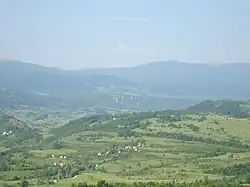 | |
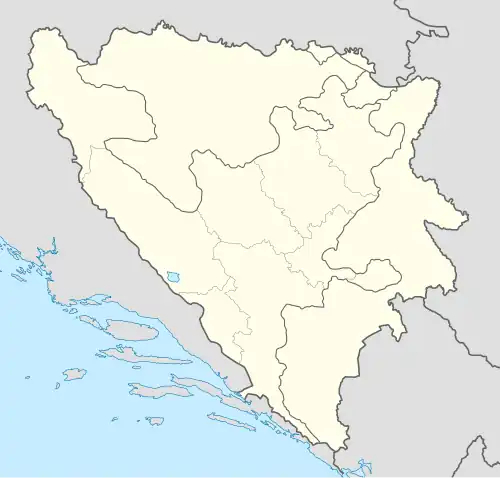 Jasenovi Potoci | |
| Coordinates: 44°17′21″N 16°51′30″E / 44.2892°N 16.8583°E | |
| Country | |
| Entity | |
| Geographical Region | Bosanska Krajina |
| Municipality | Mrkonjić Grad |
| Area | |
• Total | 26.22 km2 (10.12 sq mi) |
| Population | |
• Total | 98 (100.0% Serbs) |
| Demonym | Potočar |
Jasenovi Potoci (Serbian Cyrillic: Јасенови Потоци) is a settlement located in the Municipality of Mrkonjić Grad, of the Republika Srpska Entity in Bosnia and Herzegovina. It is in close proximity to three neighboring municipalities; Glamoc, Šipovo, and Ribnik. The settlement is located under the Dinaric Alps.
Etymology
The Settlement's name, Jasenovi Potoci derives from local ash trees and streams which are largely prevalent in this area.[1]
Geography
Jasenovi Potoci is the farthest village from its municipality capital Mrkonjić Grad (40km). The settlement is bordered by settlements Mlinište, Podgorija, Pecka, and Vrbljani. Some inhabitants of Potoci are tied to neighboring Ravna Mliništa for haymaking and its grasslands perfect for Shepherds.
The settlement is locally divided by local tales and settlers with areas of it being known as Ljubišina Dolina, Iverići, Jastrebinja, Đundići, Lipa, Bara, Palalići, and Jojikići.
The settlement is situated at an elevation from 700 to 1,143 meters. The three springs of the Sana river can be found near the settlement area.[2]
Economy
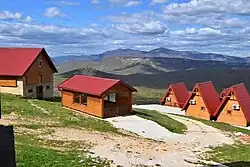
The economy of Jasenovi Potoci, although small, is supported mainly by the wood-cutting industry,[3] and tourist attractions such as the recenty built Potočarska Panorama which are bungalows and the springs of the Sana. The Pliva springs are also located nearby to this settlement.
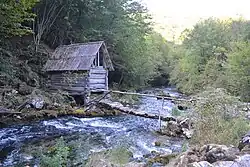
History
Ottoman Empire
Within the region, Ottoman oppression was particularly strong and in force with Baraći being controlled by Fahri-Beg Filipović, Derviš-Beg Filipović, and Mustafa Ribić, however due to the terrain and forestry of the area it provided a large outpour of local outlaws and hajduks such as an alleged Hajduk Gvozdenac.[4]
World War One
In the first World War, five Serb volunteers from this village participated in the war and were on the Albanian Golgatha and the Solun front were Simo Ubiparip[5], Jovan Ubiparip, Jevto Ubiparip, Mićo Palalić, and Lazo Lazić.[6]
World War Two
Insurgency
Due to Ustaše repression, on July 29, 1941, the insurgents from the village, attacked Ustaše strongholds in Čardak and Mlinište and captured the positions of the Ustaše. Then, in retaliation, the Ustashas killed Janko Stakić and Milan Ubiparip near the Ćorović Hotel in Mlinište. According to Mirko Kokeza from the village, these were the first civilian victims in this area. A war ambulance was immediately organized in Čardak. On July 30, 1941, the insurgents attacked and disarmed the Ustaše stronghold in Gerzovo. On August 2, 1941, the insurgents met the Ustaše in Štrbina. Ten insurgents died in this battle. In memory of this event, a large public gathering is held in Štrbina every year on Ilindan, August 2. In the second half of August and the first half of September 1941, the insurgents fought against the Ustashas around the railway station in Mlinište as best they could, poorly armed and poorly organized, to prevent further persecution.[7]
In September 1941, the Ustaše massacred 105 civilians throughout the region as a retribution against the insurgency.[8]
Yugoslav Partisans and Mlinište
The Supreme Headquarters in Mlinište 1942. In June 1942, after the 3rd enemy offensive, in the midst of the Battle of the Neretva, Tito decided to march the partisan military formations from eastern to western Bosnia. This march of the proletarian and shock brigades had the task of encouraging a stronger development of the Partisans in the western parts of the country, connecting the free territory of Bosnia, Dalmatia and Krajina, filling the partisan units with new fighters and treating the wounded. The 3rd Krajina Partisan Detachment was formed here. The 68 Proletarian Brigades, together with the Supreme Headquarters of the Partisans and the Communist Party, arrived in western Bosnia in the autumn of 1942 after this march, which lasted about 100 days. And, just before the historic operation to liberate Bihać, the creation of the "Bihać Republic", the creation of AVNOJ, USAOJ, the leadership of the Yugoslav revolution, led by Josip Broz Tito, resided in Mlinište, due to its high altitude and forested terrain. The details of the activities of the Supreme Headquarters of the Partisans, Tito and the Central Committee of the CPY in Mlinište have not been sufficiently examined, but it is known that from here, from Mlinište, Tito led the revolution and that preparations were made here for the further course of the revolution and the construction of a new government and a new state. Event in Jasenovi Potoci In the fall of 1942, during the stay of the Supreme Staff and Tito in Mlinište, the Zlatarski Battalion prepared an event in Jasenovi Potoci, which was attended by, in addition to the people from this village, Josip Broz Tito, Milovan Đilas and some other members of the political and military leadership of the Partisans. [9]
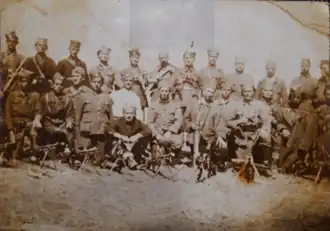
Chetnik Takeover
Towards the end of the war, the village was held by the third Chetnik battalion of Petar Kočić, the local commander of the village was Tode Todorović Noktaš, during the Up to 20 Chetniks that died hailed from this village. Atleast 17 people of this settlement were killed by the Ustaše throughout the war as part of the genocide of Serbs with numerous other surrounding villages also suffering the same fate, if not worse.[10]
Demographics
According to the official census of 1991, Jasenovi Potoci had 284 residents, all of them were Serbs.[11]
| Nationality[12][13] | 2013 | 1991 | 1981 | 1971 | 1961 | 1953 | 1948 |
| In Total: | 98 (100,0%) | 284 (100,0%) | 475 (100,0%) | 618 (100,0%) | 854 (100,0%) | 747 (100,0%) | 719 (100,0%) |
| Serbs | 98 (100,0%) | 283 (99,60%) | 472 (99,36%) | 615 (99,51%) | 854 (100,0%) | 747 (100,0%) | 719 (100,0%) |
| Yugoslavs | 3 (0,64%) | ||||||
| Others | 1 (0,40%) | 3 (0,49%) | |||||
| Households | N/A | N/A | 134 | 138 | 147 | 128 | 122 |
Notable people
- Vojo Ubiparip, Professional football player for Spartak Subotica
- Gojko Ubiparip, Chairmen of the Executive Council of SR BiH from (1984-1986)
- Rajko Ubiparip, former Minister of Industry of Republika Srpska and former general director of the Modriča Oil Refinery
- Dejan Todorović, Professional basketball player for El Calor de Cancún of the LNBP
Gallery
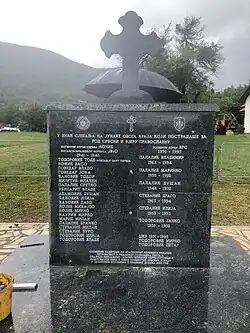
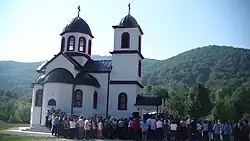
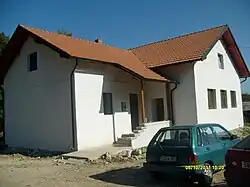
References
- ^ Udovčić 2007, p. 20.
- ^ "Ljepotica Sana jedna od najljepših u BiH". inmedia.ba (in Bosnian). 2021-01-26. Retrieved 2022-03-23.
- ^ Kaurin, Gojko. "God Impex".
- ^ Udovčić 2007, p. 19.
- ^ Udovčić 2007, p. 29.
- ^ Udovčić 2007, p. 28.
- ^ Udovčić 2007, p. 60.
- ^ Udovčić 2007, p. 62.
- ^ Udovčić 2007, p. 68.
- ^ Udovčić 2007, p. 49.
- ^ Национални састав становништва — Резултати за Републику по општинама и насељеним мјестима 1991, статистички билтен бр. 234, Издање Државног завода за статистику Републике Босне и Херцеговине, Сарајево.
- ^ Савезни завод за статистику и евиденцију ФНРЈ и СФРЈ: Попис становништва 1948, 1953, 1961, 1971, 1981. и 1991. године.
- ^ "Popis 2013 u BiH". www.statistika.ba. Retrieved 2022-03-26.
Literature
Udovčić, Rade (2007). Baraći i Baraćani (in Serbian). Mrkonjić Grad: JU Kulturni Centar, Petar Kočić. ISBN 978-99938-888-0-2.